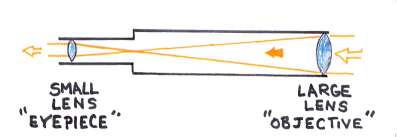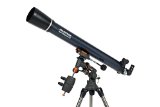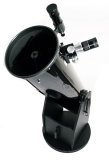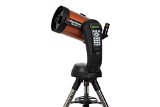The Physical Differences
The Refractor Telescope This is an image of a refractor telescope and it is what we usually think of when we think telescope. There is a big lens on one end and a small lens or eyepiece on the other end. The light comes in through the big lens and travels the length of the tube down to the little lens where you look in.

The Reflector Telescope
The reflector telescope gets its name because it uses a mirror to reflect light back up the tube and this mirror is parabolic shaped (depressed in the middle like a saucer or bowl) so it bends the light as it is reflected. The light is bounced back up to the tube to a secondary mirror that bounces it out of the tube to the eyepiece where you look.

The viewing Differences
Each type of telescope has its benefits and the refractor telescope excels when it comes to looking at objects that have some width to them. If your primary goal is to look at the moon, the planets and terrestrial objects a refractor is the best choice. But, refracting telescopes have definite size limits. It is very expensive to make large lenses where as it is much more cost economical to make very large mirrors for reflecting telescopes. So, if you want to get a lot of light gathering power in the form of a bigger telescope so you can really look into the deep space objects then a reflector is the best choice.
Cost
The cost of a refractor per opening size (aperture) is staggering. A refractor telescope with a 5 inch lens will easily run you in the range of three to four thousand dollars! wow. Where as you can get a reflector telescope with a mirror of 6 inches for a couple hundred dollars and an 8 inch mirror for around five hundred dollars. You can spend the same three to four thousand dollars on a whopping 12 or 14 inch reflector and get some astonishing light gathering power.
There is a compromise between these two types of telescopes. It falls in the middle of light gathering power and in the middle of cost and this type of telescope is the catadioptric. The catadioptric telescope uses both a lens at the front and a mirror at the back. So it takes the best from both worlds. You can get a decent catadioptric telescope in the mid range prices.
Rough Prices:
An eight inch refractor would cost you in excess of 5,000 dollars, an eight inch reflector can be had at around 500 dollars and an eight inch catadioptric will run you around 1,000 dollars.
Here is a look at some real examples of three types of telescopes.
Refractor

Celestron 21064 AstroMaster 90 EQ Refractor Telescope
If you're looking for a dual-purpose telescope appropriate for both terrestrial and celestial viewing, then the AstroMaster Series is for you. Each AstroMaster model is capable of giving correct views of land and sky. The AstroMaster Series produce bright, clear images of the Moon and planets. It is easy to see the moons of Jupiter and the rings of Saturn with every one of these fine instruments. For views of the brighter deep space objects like galaxies and nebulae, we recommend the larger aperture and light gathering ability of the Newtonian reflectors.
Reflector Telescope
  
Zhumell 10-inch Dobsonian Reflector Telescope
This ten inch telescope shows the real power in light gathering you can get with a reflector at a very reasonable price. Around half the price of a reflector with a 5" lens!
Catadioptric (Schmidt-Cassegrain)

Celestron NexStar 6 SE Telescope
6-inch Schmidt-Cassegrain telescope; StarBright XLT high transmission coatings come standard StarPointer finderscope to help with alignment and accurately locating objects Quick-release fork arm mount, optical tube, and accessory tray for no-tool setup SkyAlign allows you to align on any three bright celestial objects, making for a fast and easy alignment process Nearly 40,000 object database with 200 user-definable objects and expanded information on over 200 objects |
![]()









